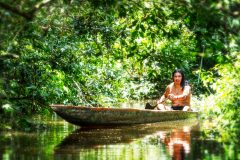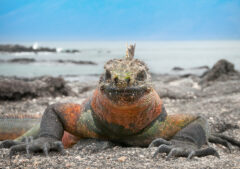Where to go when - our guide to Ecuador & Galapagos Islands
December - February
This is the wet season in the Andean highlands, including Otavalo, Quito, the Avenue of the Volcanoes and Cuenca. However, the region enjoys year round spring-like temperatures (daytime 21°C average) with a good amount of sunshine in the mornings. Short heavy afternoon downpours are common, particularly in December. January to mid-February receives a little less rain, but it picks up again mid February.
The marginally warmer cloud forests reserves of Mindo, Mashpi and Bellavista see less sunshine and more rain than the highlands during these months. The rainy season is considered the best time for birdwatchers and the annual bird count takes place in December.
Christmas is a family celebration with many shops and restaurants closed. New Year sparks big celebrations, with many heading to the milder lower altitude spa town of Baños (1800m), or to the Pacific beaches for sunny blue-sky days, average highs of 30°C and rising sea temperatures. Being the wet season here, late afternoon tropical downpours are common.
In the Galapagos you can expect clear blue skies and rising temperatures (from average highs of 26°C in December to 30°C in February) as the wet season starts in December. Light afternoon showers, mostly in the highlands, become increasingly common and turn the arid landscapes greener. The sea gets warmer by the month, rising from 23°C to 25°C, and underwater visibility means fantastic snorkelling and diving. It’s a busy time on land too, with many species mating, nesting or breeding. Giant tortoise eggs begin to hatch in December and pacific green turtles lay eggs on the beaches in January, which is also a great time for swimming with penguins. Marine iguanas become brightly coloured and flamingos can be seen much more easily as they nest in February.
In the Amazon you can expect average highs of 30°C most of the year and intense tropical downpours at any time, although January and February experience (relatively) lower rainfall. River navigation becomes trickier but forest trails are easier to explore and water levels in rivers & lakes are lower making the exposed sandy banks a great place to spot caiman, beach nesting birds and mammals. Lakes become more concentrated with fish, with the rich pickings attracting certain birds and animals.
Carnival (February/March) is celebrated throughout the country with lots of music, dance and colourful parades. Boisterous street festivities include flour and water throwing from which no bystander is immune!
22°C Average max daytime temperature
9°C Average min nighttime temperature
18 days per season rainfall
None humidity

March - May
In the Andean highlands, including Otavalo, Quito, the Avenue of the Volcanoes and Cuenca, the year round spring-like temperatures continue with average highs of 18-20°C and lows of 8-10°C. These months see more rain, particularly March and April (the wettest months of the year). However, rain still tends to come as heavy afternoon downpours and whilst overcast skies are common, you can still expect some sunny days. It’s a few degrees warmer with more rain in the cloud forest reserves of Mindo, Mashpi and Bellavista but bird watchers consider it the best time due to an increase in migratory birds.
Semana Santa (Easter) is marked with traditional religious processions, particularly impressive on Good Friday in Quito but something interesting takes place pretty much everywhere.
Hot and humid, with average highs of over 30°C, the frequency and intensity of rain in the Amazon increases in March with the onset of the wet season. Lakes fill up and much of the forest floor floods. River navigation becomes easier and with many trees flowering or producing fruit, there are excellent opportunities to spot birds and primates feeding in the canopy. Whether wet or dry, wildlife-spotting is always excellent; some species are more easily seen, and in larger numbers in one season and others in the opposing season.
On the central and southern Pacific coast the hot sunny rainy season peaks in April before transitioning in May to the start of the cooler and less popular dry season, although temperatures can still reach 30°C! Beaches can get crowded in Easter.
The Galapagos Islands continue to get hotter, averaging 31°C by Apr. Days are clear with almost permanent sunshine and light afternoon showers in the now lush green highlands. Snorkelling and diving is excellent with warm seas (25°C), fantastic visibility and lots of sea turtles and playful young sea lions. Many land species continue to mate, nest and breed; frigate birds display their impressive red pouches in March and the waved albatross arrive en-mass in April. May sees the start of the wonderful blue footed booby courtship displays as the season transitions towards the upcoming cooler dry season. Average highs drop to a more comfortable 26°C and nutrient rich cooler waters bring an explosion in marine activity.
22°C Average max daytime temperature
9°C Average min nighttime temperature
20 days per season rainfall
None humidity

June - August
In the Andean highlands, including Otavalo, Quito, the Avenue of the Volcanoes and Cuenca, June marks the arrival of dry season. These are the sunniest and driest although coolest months of the year, with average highs of around 19°C during the day and chilly nights. July and August are the best months for hiking in the highlands whilst the birding trails in the lower altitude cloud forest reserves of Mindo, Mashpi and Bellavista are less muddy and visitors can enjoy more sun, less rain and temperatures of around 24°C. On the summer solstice (16-24th June) Indigenous communities throughout the highlands celebrate Inti Raymi (Festival of the Sun) with ancient rituals and colourful cultural events.
June is the hottest and wettest month in the Amazon. Temperatures are over 32°C and frequent intense afternoon rains swell rivers and lakes to their highest levels. With much of the lower lying forest floor flooded, navigation by expedition cruise or motorised canoes is easy and brings a unique dimension to wildlife viewing. Marking the transition into the dry (or drier) season, total rainfall and average temperatures drop off in July and again in August, although with an average of 30°C it’s still hot and humid. Waters recede and the exposed riverbanks and beaches once again become the best place to spot wildlife, including caiman and mammals.
These are the cooler dry season months on the Pacific coast, although it is still hot with average highs of 28°C. With very little rain, humidity also drops and the ocean continues to cool down, intensifying the almost permanent haze which considerably reduces hours of sunshine during this time. Humpback whales start to arrive in June and July and August are the best months for whale watching.
The Galapagos dry season starts in June, with lower average highs of 24°C and cooler evenings that may require a light sweater. Colder ocean currents (23-21.5°C) create trade winds and choppier seas, hazy skies and a light mist in the highlands. They also bring lots of nutrients creating fantastic underwater wildlife opportunities to see large shoals of fish and pods of dolphins and humpbacks, orcas and whale sharks in July and August. On land, giant tortoises descend from the highlands to nest in June while many sea bird colonies are particularly active during these months, including the iconic flightless cormorants whose beautiful courtship displays begin in July. August sees the beginning of the sea lion pupping season.
22°C Average max daytime temperature
8°C Average min nighttime temperature
8 days per season rainfall
None humidity
-32x24-c-bottom.jpg)
September - November
September is the final month of the cooler dry season in the Andean highlands, including Otavalo, Quito, the Avenue of Volcanoes and Cuenca. There’s a little more rain and less sunshine than in preceding months although the year round spring-like temperatures continue with a marginally elevated average high of 20°C and low of 9°C. The wet season rains arrive in October, increasing into November. Sunny mornings are still common, but there are fewer hours of sunshine and more overcast days. The lower altitude cloud forest reserves of Mindo, Mashpi and Bellavista are a few degrees warmer but experience longer periods of rain, usually in the afternoon. Serious birders consider October to be the start of the best time for bird watching.
The Amazon is hot and humid with average temperatures at 30°C. September sees the onset of another wet season, with frequent and intense rainfall increasing through to November. High rivers make for easy navigation by expedition cruise or motorised canoe and much of the forest floor floods once again, allowing for deeper penetration into the rainforest. Rain or shine, wildlife is ever present with plenty to see in the flowering forest canopy and huge open sky.
The cooler dry season continues on the central and southern Pacific coast. It isn’t cold (average 28°C) but there’s little sunshine thanks to the hazy skies caused by the persisting cool ocean currents. Humpback whale watching is still excellent in September and October.
The Galapagos Islands’ cooler dry season continues into September and October (average highs of 24°C, lows of 19°C). The cool nutrient rich ocean currents (22°C) and trade winds continue, with choppier seas, hazy skies and low mist in the highlands. Snorkelling and diving is fantastic, with September and October the best months for spotting humpback whales, orcas and whale sharks as well as enormous pods of dolphins and large groups of rays and sharks. Water temperatures rise to 23°C in November, the winds ease and the seas settle as the climate transitions towards the warmer wet season to come. Male fur seals fight to control harems during these months whilst Flamingos and many marine birds, including Penguins, blue and red footed boobies are nesting and raising their chicks.
Dia de Todos los Santos (all souls day/day of the dead) is celebrated everywhere on 2nd November. A colourful, sombre yet joyous affair, relatives visit the cemetery to decorate graves with flowers and commemorate their dead with picnics of their favourite foods. Festivities spill out of the graveyards and stalls sell traditional breads, sweets and refreshments.
22°C Average max daytime temperature
8°C Average min nighttime temperature
16 days per season rainfall
None humidity

Papagaio
Your edit for Latin American inspiration
Our exciting range of articles on Latin America explore everything from iconic destinations and lesser-known cultural gems to delicious traditional recipes. You’ll also find exclusive travel tips, first-hand client reviews and the chance to get your personal questions answered by our travel experts.
View Extraordinary Inspiration






































